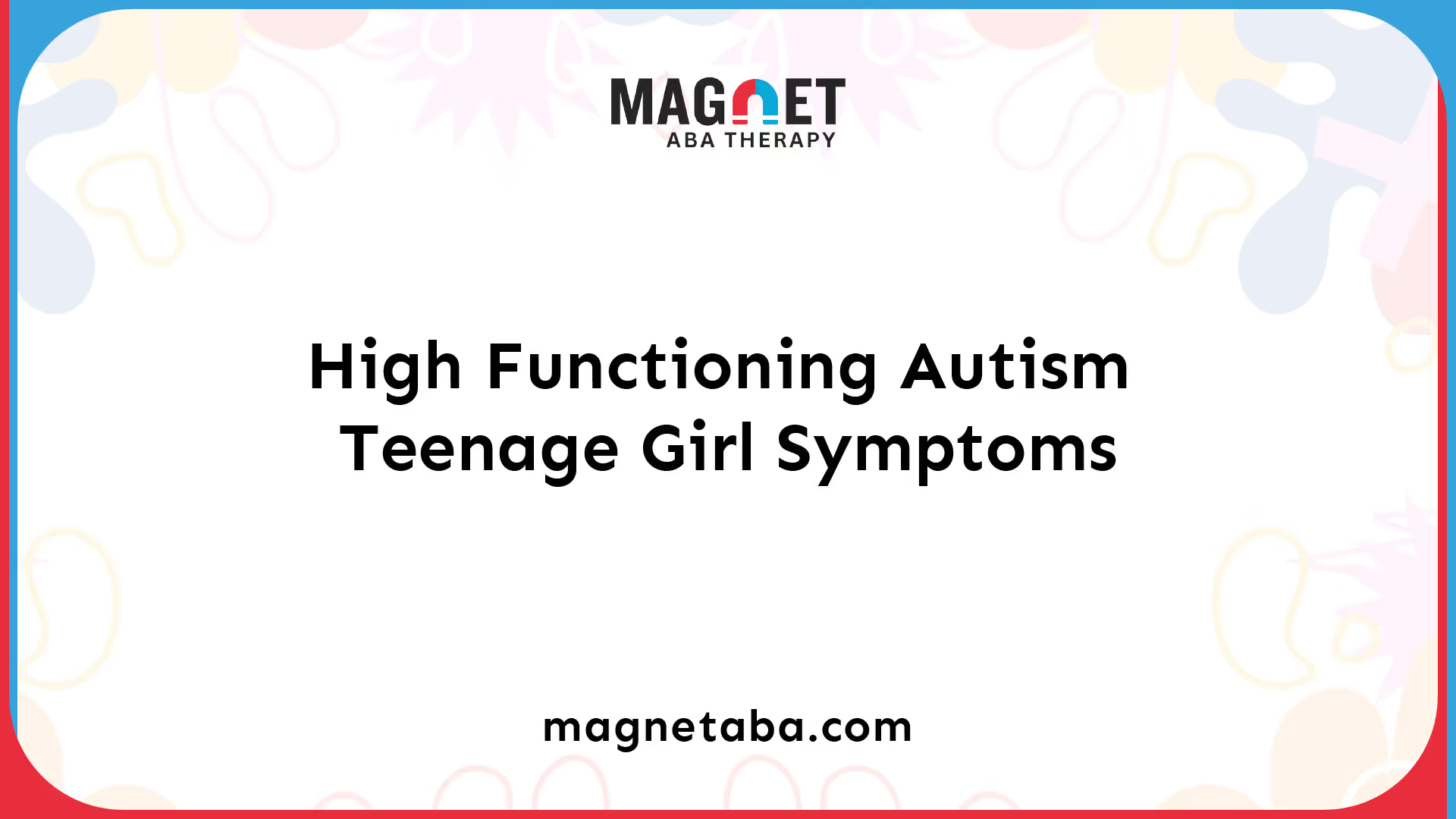Understanding High-Functioning Autism
High-functioning autism is a term used to describe individuals on the autism spectrum who have average or above-average intellectual abilities and good language skills. While autism can affect both boys and girls, there are some differences in the way symptoms manifest in teenage girls compared to teenage boys.

Symptoms in Teenage Girls
Autistic girls may exhibit certain behaviors and characteristics that are distinct from boys on the spectrum. Research suggests that girls with autism tend to have more advanced vocabulary skills compared to boys and are often less likely to imitate their parents Psych Central. This can sometimes mask their difficulties in social communication and make it harder to recognize their autism.
Girls with high-functioning autism may also develop coping mechanisms to camouflage their symptoms. This means they may consciously or unconsciously learn to hide or mimic social behaviors to fit in with their peers Psych Central. As a result, it may be more challenging to identify autism in girls, leading to underdiagnosis or delayed diagnosis.
Cultural beliefs and expectations can also contribute to missed autism diagnoses in girls. Societal perceptions that girls should be quieter, less assertive, and more socially skilled may mask certain autism traits in girls Verywell Health. Behaviors that might be seen as positive in girls could be viewed as disruptive in boys, leading to differences in intervention and support.
Symptoms in Teenage Boys
While girls with high-functioning autism may exhibit certain distinct behaviors, there are also common symptoms that are shared by both boys and girls on the spectrum. These symptoms include difficulties with social interaction, restricted interests, repetitive behaviors, and challenges with sensory processing.
Boys with high-functioning autism may display more obvious and stereotypical autism traits, such as intense or specific interests, repetitive motions or behaviors, and difficulties in social communication. However, it's important to note that there is a wide range of individual differences within the autism spectrum, and not all boys will exhibit the same symptoms in the same way.
Research has shown that girls with autism tend to display fewer repetitive and restricted behaviors compared to boys Stanford Medicine. Brain differences between boys and girls with autism may help explain this discrepancy. It's essential to consider these differences when identifying and supporting individuals with high-functioning autism.
Understanding the unique symptoms and characteristics of high-functioning autism in teenage girls and boys is crucial for early identification and appropriate intervention. By recognizing the specific challenges faced by autistic girls and boys, parents and professionals can provide tailored support to help them thrive and reach their full potential.
Social Skills Development
For teenagers with high-functioning autism, developing strong social skills is crucial for building healthy relationships, making friends, and enhancing their overall well-being and sense of belonging. Social skills enable them to navigate various social situations, from everyday interactions to family gatherings and teenage parties. It's important to note that social development for autistic teenagers may align more with their developmental stage rather than their age in years. Friendships may be based on shared interests rather than solely on emotions.
Importance of Social Skills
Social skills play a vital role in the lives of autistic teenagers. By honing their social abilities, they can effectively communicate, understand social cues, and engage in interactions that promote positive connections with others. Some key benefits of developing social skills include:
- Improved relationships: Building and maintaining healthy relationships is essential for one's overall happiness and well-being. With strong social skills, autistic teenagers can establish meaningful connections with peers, family members, and the wider community.
- Enhanced self-esteem: Mastering social skills can boost self-confidence and self-esteem. Autistic teenagers who feel more competent in social situations tend to have a more positive self-perception.
- Better emotional regulation: Social skills development often involves learning how to manage emotions effectively. By understanding their emotions and those of others, autistic teenagers can navigate social interactions with greater ease and reduce anxiety or stress.
- Increased independence: Social skills empower autistic teenagers to become more independent in various aspects of life. From ordering food at a restaurant to advocating for their needs, strong social skills can enhance their ability to navigate the world with confidence.
Strategies for Enhancing Social Skills
There are various strategies and interventions that can support autistic teenagers in developing and enhancing their social skills. Some effective approaches include:
- Role-playing: Engaging in role-playing scenarios allows autistic teenagers to practice and refine their social skills in a safe and controlled environment. This technique enables them to learn appropriate responses and behaviors for different social situations.
- Utilizing social media: Social media platforms can provide opportunities for autistic teenagers to connect with others who share similar interests. Online communities and groups can serve as a valuable space for practicing social skills and building friendships.
- Social skills training programs: Programs such as Stop Think Do, Secret Agent Society (SAS), and PEERS® offer structured social skills training specifically designed for autistic teenagers. These programs teach various social skills, including non-verbal communication, understanding social and emotional rules, and problem-solving in social contexts.
- Incorporating social stories: Social stories, which use narratives and visuals, can help autistic teenagers understand social situations, expectations, and appropriate responses. Social stories provide guidance and support for navigating specific social scenarios.
- Video modeling: By watching videos that demonstrate desired social behaviors, autistic teenagers can learn and imitate appropriate social skills. Video modeling can be particularly effective for individuals with autism, as it provides clear visual examples.
- Peer training: Peer training involves teaching typically developing children strategies for interacting with autistic teenagers who have social skills challenges. This approach provides valuable opportunities for autistic teenagers to practice social skills with their peers in a supportive and inclusive environment.
It's important for parents, educators, and therapists to work together to develop tailored treatment plans that address the specific social needs of autistic teenagers. By employing a combination of these strategies, interventions, and support systems, autistic teenagers can enhance their social skills and thrive in their social interactions.
Challenges Faced by Autistic Teenage Girls
Autistic teenage girls face unique challenges that may differ from their male counterparts. Understanding these challenges can help parents and caregivers provide the necessary support and interventions. In this section, we will explore two significant challenges faced by autistic teenage girls: communication and comprehension difficulties, and sensory sensitivities.
Communication and Comprehension
Autistic teenage girls may experience challenges in communication and comprehension. Research has shown that autistic girls tend to have an advanced vocabulary compared to autistic boys, but they may struggle with using language effectively in social situations. They may have difficulty understanding and interpreting non-verbal cues, such as facial expressions and body language, which can impact their ability to navigate social interactions.
Additionally, autistic teenage girls may find it challenging to express their thoughts and feelings verbally. They may have difficulties initiating and maintaining conversations, and their communication style may appear different from neurotypical peers. It's important for parents and caregivers to provide support and create opportunities for developing effective communication skills, such as social skills training and speech therapy.
Sensory Sensitivities
Sensory sensitivities are another common challenge faced by autistic teenage girls. Many individuals on the autism spectrum experience heightened sensitivity to sensory stimuli, including sights, sounds, smells, textures, and tastes. However, the specific sensitivities may vary among individuals.
Autistic teenage girls may be particularly sensitive to certain sensory inputs, which can lead to discomfort, anxiety, or meltdowns in overwhelming environments. For example, they may struggle with loud noises, bright lights, crowded spaces, or certain textures of clothing. It's important for parents and caregivers to create a sensory-friendly environment and provide tools and strategies to help manage sensory sensitivities.
Understanding and addressing these challenges can significantly improve the well-being and quality of life for autistic teenage girls. It's crucial to tailor interventions and support to meet their unique needs, taking into account their communication styles, sensory sensitivities, and individual strengths. By providing a supportive and inclusive environment, we can empower autistic teenage girls to navigate adolescence with confidence and resilience.
Gender Differences in Autism Diagnosis
When it comes to diagnosing autism, there are notable differences between boys and girls. Traditionally, boys have been diagnosed with autism at a much higher rate than girls, with a ratio of approximately 4:1. This is partly due to biased diagnostic criteria based on the typical presentation of the disorder in boys. However, it's important to recognize that girls with autism may exhibit different symptoms and face unique challenges.
Diagnostic Disparities
Research from 2019 suggests that females with autism are more likely to camouflage their symptoms compared to males. This means that girls may learn to mask or hide their autistic traits in social situations, making it more difficult to identify their symptoms. As a result, girls may require a higher number or more intense symptoms to receive a diagnosis, leading to underdiagnosis or delayed diagnosis.
The Diagnostic and Statistical Manual of Mental Disorders, Fifth Edition (DSM-5), which is widely used for diagnosing autism, lists the same symptoms for males and females. However, diagnostic bias and the female protective effect, where girls may have a higher genetic threshold for developing autism, may contribute to the differences in diagnosis rates between genders. It is important for healthcare professionals to be aware of these gender differences and consider the individual traits and challenges that girls with autism may face.
Gender-Specific Symptoms
While the DSM-5 does not list gender-specific symptoms for autism spectrum disorder, studies and anecdotal evidence suggest that girls with autism may exhibit different patterns of behavior compared to boys. Girls often have subtle autism traits and may learn to mask their symptoms, making it challenging to recognize their needs and provide appropriate support.
Cultural beliefs and expectations can also contribute to missed autism diagnoses in girls. Societal perceptions that girls should behave in quieter and less assertive ways may lead to the dismissal of autism symptoms in girls. Behaviors that might be seen as positive or acceptable in girls may be viewed as disruptive in boys, leading to differences in intervention and support [2].
It is crucial to understand and address the gender disparities in autism diagnosis to ensure that girls with autism receive the appropriate support and interventions. By recognizing the unique challenges faced by girls and being aware of the potential masking of symptoms, healthcare professionals can work towards more accurate and timely diagnoses.
Support and Interventions
When it comes to supporting teenagers with high-functioning autism, early intervention and tailored treatment plans play a crucial role in promoting their overall well-being and development. Understanding the importance of these interventions can help parents navigate the challenges associated with high-functioning autism teenage girl symptoms.
Early Intervention Importance
Early intervention is key in addressing the unique needs of individuals with autism spectrum disorder (ASD). Seeking help as soon as autism is suspected increases the chances of treatment success and can speed up a child's development. According to HelpGuide.org, early intervention is the most effective way to reduce the symptoms of autism over the lifespan.
Early intervention programs often focus on developing communication and social skills, managing sensory sensitivities, and addressing behavioral challenges. These programs are typically tailored to meet the individual needs of the teenager, taking into account their strengths, weaknesses, and specific challenges associated with high-functioning autism.
Tailored Treatment Plans
Autism is a spectrum disorder, and each individual with high-functioning autism has unique strengths and challenges. Therefore, it is crucial to develop tailored treatment plans that address the specific needs of the teenager. According to HelpGuide.org, there is no single treatment that works for everyone on the autism spectrum.
When creating a tailored treatment plan, it is essential to involve parents in the decision-making process. Parents have a deep understanding of their child's behavior, preferences, and sensitivities. By actively involving parents, professionals can gather valuable insights that contribute to the development of an effective treatment plan.
Tailored treatment plans often incorporate a combination of therapies, such as behavior therapy, speech therapy, occupational therapy, and social skills training. These therapies aim to enhance communication skills, improve social interactions, manage sensory sensitivities, and address any co-occurring conditions that may be present.
One effective intervention for children with autism is child-centered play therapy. This relationship-based intervention focuses on promoting natural play and improving joint attention skills. According to NCBI, child-centered play therapy has been shown to significantly reduce core symptoms and behavioral disorders in children with ASD.
By implementing early intervention and tailoring treatment plans to meet the individual needs of teenagers with high-functioning autism, parents can provide the necessary support and resources to help their children thrive. It is important to remember that every teenager is unique, and finding the right combination of interventions may require some trial and error.
Coping with Adolescence
Adolescence can bring unique challenges for teenagers with high-functioning autism. It is during this period that they may face executive functioning challenges and an increased risk of social isolation.
Executive Functioning Challenges
Research indicates that teens with high-functioning autism may mature at a slower pace when it comes to executive skills. Executive functioning refers to a set of mental processes that enable individuals to plan, organize, initiate activities, and work with flexibility and adaptability. Teens with autism may encounter difficulties with cognitive flexibility, organization, initiating activities, and working memory as they get older.
As high school demands increase, students with autism may struggle with tasks such as changing classes, keeping track of books and assignments, following complex directions, completing multi-phase projects, and turning in homework on time. They often require additional external support from family and school to develop planning, organization, and other executive skills [3].
To assist teenagers with high-functioning autism in coping with executive functioning challenges, it is essential to provide structured routines, visual aids, and clear expectations. Breaking tasks into smaller, manageable steps and using reminders can also help them navigate their daily responsibilities successfully.
Social Isolation Risks
Many teenagers with high-functioning autism experience social isolation and encounter difficulties in social activities. Studies have shown that a significant proportion of teens with autism never socialize with friends outside of school, are rarely invited to activities, and do not receive calls from friends. Social withdrawal tends to worsen with age for many individuals with autism spectrum disorder (ASD).
To address the risk of social isolation, it is crucial to provide opportunities for social interaction and support the development of social skills. This can include participation in structured social groups, therapy sessions focused on social communication, and involvement in community activities where teenagers can interact with their peers. Encouraging inclusive environments and fostering understanding among classmates and educators can also contribute to reducing social isolation for teenagers with high-functioning autism.
Additionally, promoting self-advocacy skills and providing guidance on navigating social situations can empower teenagers with high-functioning autism to develop meaningful connections and friendships. Creating a supportive network of family, friends, and mentors who understand their unique challenges can also provide invaluable social support.
By addressing executive functioning challenges and mitigating the risk of social isolation, parents and caregivers can help teenagers with high-functioning autism navigate the complexities of adolescence and foster their overall well-being.
References
[1]: https://psychcentral.com/autism/comparison-of-boys-and-girls-living-with-autism-spectrum-disorder
[3]: https://www.kennedykrieger.org/stories/interactive-autism-network-ian/autisminteens












